The Mother’s Day Solar Storm of 11 May 2024 and Its Effect on Earth’s Radiation Belts
Abstract
1. Introduction: The 11 May 2024 Event in the Context of Previous Storms
2. Instruments and Data
2.1. PROBA-V/EPT
2.2. SEM-2/MEPED
3. The Effects of the 11 May Storm on the Proton Radiation Belt
3.1. Protons Observed by GOES at Geostationary Orbit
3.2. Proton Injections Observed at LEO
- 1.
- The energy ranges of the measured protons are not the same for the first channel of the EPT and the fifth channel of MEPED. It is thus expected that the flux of protons observed by MEPED is higher than those observed by the EPT, since it measures fluxes at lower energy.
- 2.
- The pitch angles of the observed particles differ between the instruments. Indeed, the MEPED 90° telescope can be considered to measure fluxes of trapped particles and the 0° telescope observes the precipitating particles (at least at high latitudes and thus high L values), while EPT measures particle fluxes with a pitch angles between 60° and −60°. Thus, the EPT measures a combination of trapped and precipitating particles.
3.3. Effects in the South Atlantic Anomaly
3.4. Neutron Monitors Observations
4. Effects on the Electron Radiation Belts
4.1. Observations of New Electron Belts by EPT
4.2. EPT Profiles Showing Several Belts
4.3. Observations of Trapped Electrons by MEPED
4.4. Electron Maps
5. Discussion about Multiple Electron Belts
- (1)
- Before the storm (see dark blue line in Figure 9), there are 2 belts. For energy between 500 keV and 2.4 MeV, the maximum of the inner belt appears at L = 1.6, and the outer belt at L = 3.8 with slot at L = 2.7. For lower energy, the maximum in the inner belt is higher (L = 2).
- (2)
- During the storm (at minimum of Dst, see light blue line), electrons are injected down to low L, with a maximum of electron flux at lower L for lower energies. Pierrard et al. (2020) [19] (see their Figure 10) predicted an injection at L = 2.2 for E = 500–600 keV and L = 2.6 for E = 1–2.8 MeV at the moment of the Dst minimum for the strongest storms, by extrapolation of observations of less intense storms. These predicted depths of penetration correspond quite well to the observations, and are lower than for common storms. This shows that the radial diffusion leading to the electron injection depends on the energy and is in good agreement with predictions.
- (3)
- Due to these exceptional depths of penetration of electrons injected in the inner belt during the Dst = −412 nT geomagnetic storm, the loss mechanisms reforming the slot appears to be highly dependent on L, especially for low energies (see yellow and red lines). Loss is especially efficient at L = 2 (for all energies > 500 keV), L = 2.5 (for all energies between 500 keV and 2.8 MeV) and L = 4.1 to 3.8 slightly decreasing with time for all energies. For E < 500 keV, a loss at L = 1.5 replaces that appearing at L = 2 for higher energies, leading to a maximum of flux at L = 2 for low energy (as shown by MEPED observations).
6. Conclusions
Author Contributions
Funding
Data Availability Statement
Acknowledgments
Conflicts of Interest
References
- Kruparova, O.; Krupar, V.; Szabo, A.; Lario, D.; Nieves-Chinchilla, T.; Martinez Oliveros, J.C. Unveiling the Interplanetary Solar Radio Bursts of the 2024 Mother’s Day Solar Storm. Astrophys. J. Lett. 2024, 970, L13. [Google Scholar] [CrossRef]
- Hayakawa, H.; Cliver, E.W.; Clette, F.; Ebihara, Y.; Toriumi, S.; Ermolli, I.; Chatzistergos, T.; Hattori, K.; Knipp, D.J.; Blake, S.P.; et al. The Extreme Space Weather Event of 1872 February: Sunspots, Magnetic Disturbance, and Auroral Displays. Astrophys. J. 2023, 959, 23. [Google Scholar] [CrossRef]
- Hayakawa, H.; Bechet, S.; Clette, F.; Hudson, H.S.; Maehara, H.; Namekata, K.; Notsu, Y. Magnitude estimates for the Carrington flare in 1859 September: As seen from the original records. Astrophys. J. Lett. 2023, 954, L3. [Google Scholar] [CrossRef]
- Love, J.J.; Hayakawa, H.; Cliver, E.W. Intensity and impact of the New York Railroad superstorm of May 1921. Space Weather 2019, 17, 1281–1292. [Google Scholar] [CrossRef]
- Karan, D.K.; Martinis, C.R.; Daniell, R.; Eastes, R.W.; Wang, W.; McClintock, W.E.; Michell, R.G.; England, S.L. GOLD observations ofthe merging of the Southern Crest of the equatorial ionization anomaly and aurora during the 10 and 11 May 2024 Mother’s Day super geomagnetic storm. Geophys. Res. Lett. 2024, 51, e2024GL110632. [Google Scholar] [CrossRef]
- Pierrard, V.; Lopez Rosson, G.; Borremans, K.; Lemaire, J.; Maes, J.; Bonnewijn, S.; Van Ransbeeck, E.; Neefs, E.; Cyamukungu, M.; Benck, S.; et al. The Energetic Particle Telescope: First results. Space Sci. Rev. 2014, 184, 87–106. [Google Scholar] [CrossRef]
- Cyamukungu, M.; Grégoire, G. The Energetic Particle Telescope (EPT) concept and performances. In Proceedings of the Solar Physics and Space Weather Instrumentation IV. International Society for Optics and Photonics, San Diego, CA, USA, 21–24 August 2011. [Google Scholar]
- Cyamukungu, M.; Benck, S.; Borisov, S.; Grégoire, G.; Cabrera, J.; Bonnet, J.L. The Energetic Particle Telescope (EPT) on board PROBA-V: Description of a new science-class instrument for particle detection in space. IEEE Trans. Nucl. Sci. 2014, 61, 3667–3681. [Google Scholar] [CrossRef]
- Evans, D.; Greer, M. Polar Orbiting Environmental Satellite Space Environment Monitor; NOAA National Geophysical Data Center: Boulder, CO, USA, 2000.
- Hu, S.; Semones, E. Calibration of the GOES 6—16 High-energy proton detectors based on modelling of ground level enhancement energy spectra. J. Space Weather Space Clim. 2022, 12, 15. [Google Scholar] [CrossRef]
- Pierrard, V.; Benck, S.; Botek, E.; Borisov, S.; Winant, A. Proton flux variations during Solar Energetic Particle Events, minimum and maximum solar activity, and splitting of the proton belt in the South Atlantic Anomaly. J. Geophys. Res. Space Phys. 2023, 128, e2022JA031202. [Google Scholar] [CrossRef]
- McIlwain, C.E. Magnetic coordinates. Space Sci. Rev. 1966, 5, 585–598. [Google Scholar] [CrossRef]
- Yando, K.; Millan, R.M.; Green, J.C.; Evans, D.S. A Monte Carlo simulation of the NOAA POES medium energy proton and electron detector instrument. J. Geophys. Res. Space Phys. 2011, 116, A10231. [Google Scholar] [CrossRef]
- Lopez Rosson, G.; Pierrard, V. Analysis of proton and electron spectra observed by EPT/PROBA-V in the South Atlantic Anomaly. Adv. Space Res. 2017, 60, 796–805. [Google Scholar] [CrossRef]
- Selesnick, R.; Baker, D.; Jaynes, A.; Li, X.; Kanekal, S.; Hudson, M.; Kress, B. Observations of the inner radiation belt: CRAND and trapped solar protons. J. Geophys. Res. Space Phys. 2014, 119, 6541–6552. [Google Scholar] [CrossRef]
- Selesnick, R.; Looper, M.; Mewaldt, R. A theoretical model of the inner proton radiation belt. Space Weather 2007, 5, S04003. [Google Scholar] [CrossRef]
- Selesnick, R.; Hudson, M.; Kress, B. Injection and loss of inner radiation belt protons during solar proton events and magnetic storms. J. Geophys. Res. Space Phys. 2010, 115, A08211. [Google Scholar] [CrossRef]
- Pierrard, V.; Lopez Rosson, G. The effects of the big storm events in the first half of 2015 on the radiation belts observed by EPT/PROBA-V. Ann. Geophys. 2016, 34, 75–84. [Google Scholar] [CrossRef][Green Version]
- Pierrard, V.; Botek, E.; Ripoll, J.F.; Cunningham, G. Electron dropout events and flux enhancements associated with geomagnetic storms observed by PROBA-V/EPT from 2013 to 2019. J. Geophys. Res. Space Phys. 2020, 125, e2020JA028487. [Google Scholar] [CrossRef]
- Benck, S.; Mazzino, L.; Cyamukungu, M.; Cabrera, J.; Pierrard, V. Low altitude energetic electron lifetimes after enhanced magnetic activity as deduced from SAC-C and DEMETER data. Ann. Geophys. 2010, 28, 849–859. [Google Scholar] [CrossRef]
- Baker, D.; Jaynes, A.; Hoxie, V.; Thorne, R.; Foster, J.; Li, X.; Fennell, J.; Wygant, J.; Kanekal, S.; Erickson, P.; et al. An impenetrable barrier to ultrarelativistic electrons in the Van Allen radiation belts. Nature 2014, 515, 531–534. [Google Scholar] [CrossRef]
- Ozeke, L.G.; Mann, I.R.; Murphy, K.R.; Degeling, A.W.; Claudepierre, S.G.; Spence, H.E. Explaining the apparent impenetrable barrier to ultra-relativistic electrons in the outer Van Allen belt. Nat. Commun. 2018, 9, 1844. [Google Scholar] [CrossRef]
- Reeves, G.D.; Friedel, R.H.; Larsen, B.A.; Skoug, R.M.; Funsten, H.O.; Claudepierre, S.G.; Fennell, J.F.; Turner, D.L.; Denton, M.H.; Spence, H.E.; et al. Energy-dependent dynamics of keV to MeV electrons in the inner zone, outer zone, and slot regions. J. Geophys. Res. Space Phys. 2016, 121, 397–412. [Google Scholar] [CrossRef]
- Vette, J.I. The AE-8 Trapped Electron Model Environment; NSSDC/WDC-A-R&S 91-24; National Aeronautics and Space Administration, Goddard Space Flight Center: Greenbelt, MD, USA, 1991.
- Pierrard, V.; Ripoll, J.F.; Cunningham, G.; Botek, E.; Santolik, O.; Thaller, S.; Kurth, W.S.; Cosmides, M. Observations and simulations of dropout events and flux enhancements in October 2013: Comparing MEO equatorial with LEO polar orbit. J. Geophys. Res. Space Phys. 2021, 126, e2020JA028850. [Google Scholar] [CrossRef]
- Ripoll, J.F.; Thaller, S.; Hartley, D.; Cunningham, G.S.; Pierrard, V.; Kurth, W.S.; Kletzing, C.A.; Wygant, J.R. Statistics and empirical models of the plasmasphere boundaries from the Van Allen Probes for radiation belt physics. Geophys. Res. Lett. 2022, 49, e2022GL101402. [Google Scholar] [CrossRef]
- Dahmen, N.; Sicard, A.; Brunet, A.; Santolik, O.; Pierrard, V.; Botek, E.; Darrouzet, F.; Katsavrias, C. FARWEST: Efficient computation of wave-particle interactions for a dynamic description of the electron radiation belt diffusion. J. Geophys. Res. Space Phys. 2022, 127, e2022JA030518. [Google Scholar] [CrossRef]
- Pierrard, V.; Botek, E.; Darrouzet, F. Improving Predictions of the 3-Dimensional Dynamic Model of the Plasmasphere. Front. Astron. Space Sci. 2021, 8, 681401. [Google Scholar] [CrossRef]
- Cunningham, G.; Botek, E.; Pierrard, V.; Cully, C.; Ripoll, J.F. Observation of High-Energy Electrons Precipitated by NWC Transmitter from PROBA-V Low-Earth Orbit Satellite. Geophys. Res. Lett. 2020, 47, e2020GL089077. [Google Scholar] [CrossRef]
- Chen, J.L.; Zou, H.; Hao, Y.X.; Ye, Y.G.; Miyoshi, Y.; Matsuoka, A.; Shinohara, I.; Teramoto, M.; Xu, S.G. A sub-relativistic electron three-belt event in the Earth’s radiation belts: Observation and explanation. J. Geophys. Res. Space Phys. 2024, 129, e2023JA032213. [Google Scholar] [CrossRef]
- Baker, D.; Kanekal, S.; Hoxie, V.; Henderson, M.; Li, X.; Spence, H.E.; Elkington, S.; Friedel, R.; Goldstein, J.; Hudson, M.; et al. A long-lived relativistic electron storage ring embedded in Earth’s outer Van Allen belt. Science 2013, 340, 186–190. [Google Scholar] [CrossRef]
- Lazutin, L.; Kuznetsov, S.; Podorol’skii, A. Dynamics of the radiation belt formed by solar protons during magnetic storms. Geomagn. Aeron. 2007, 47, 175–184. [Google Scholar] [CrossRef]

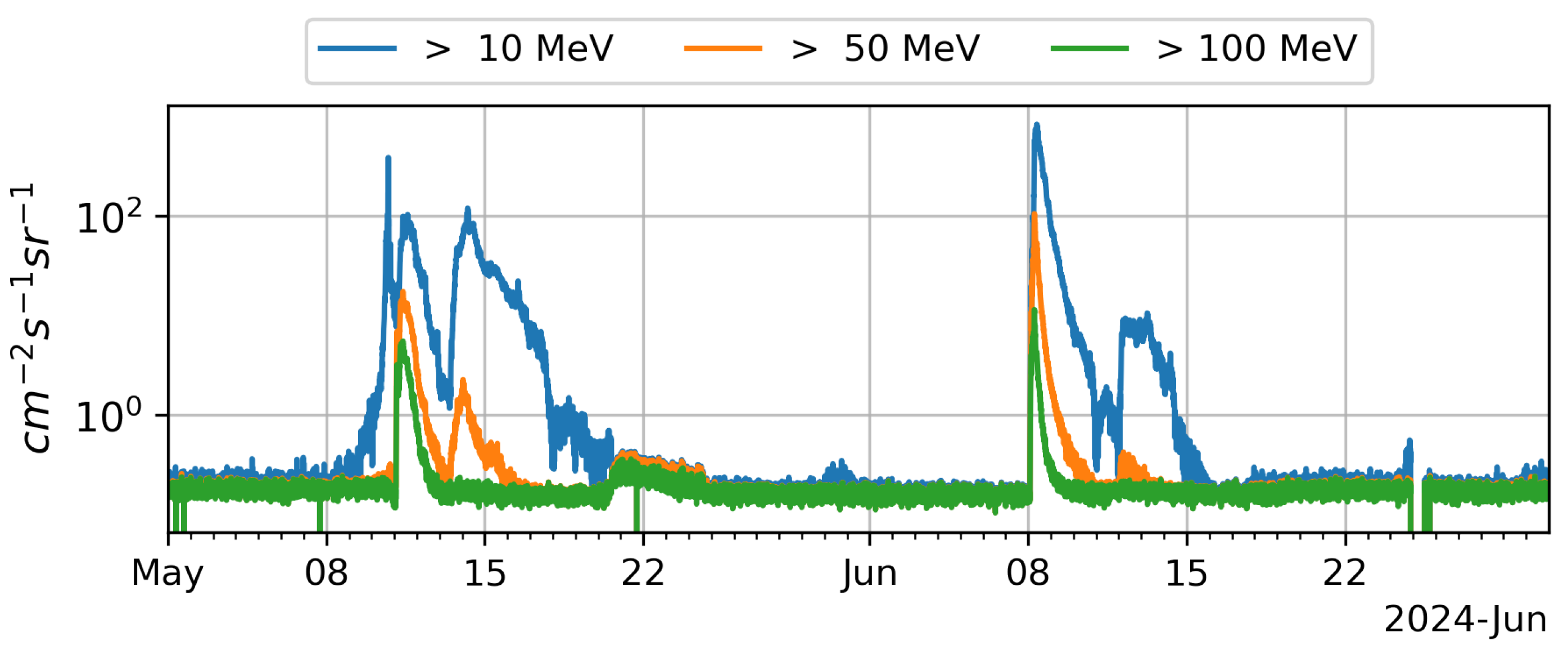

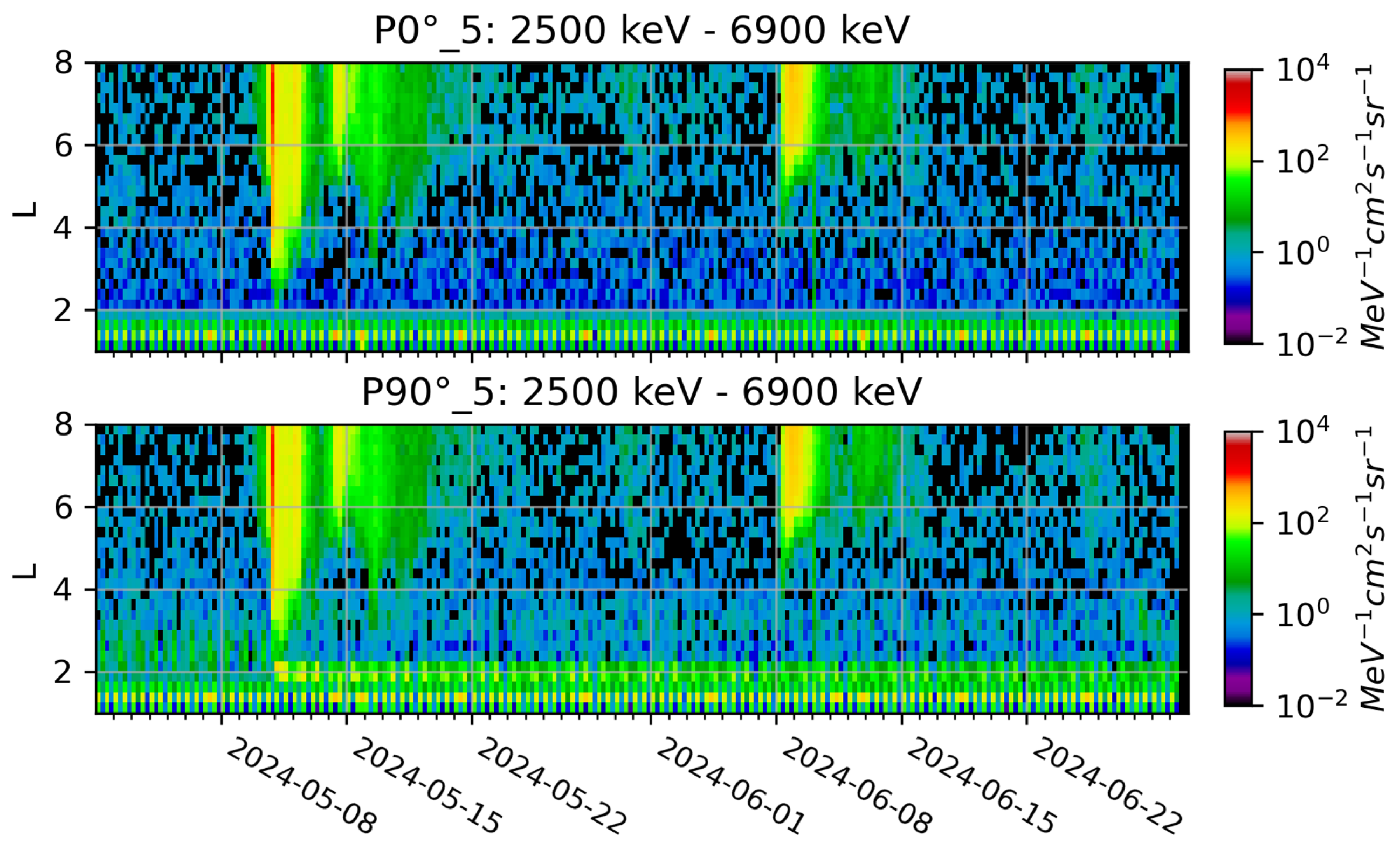
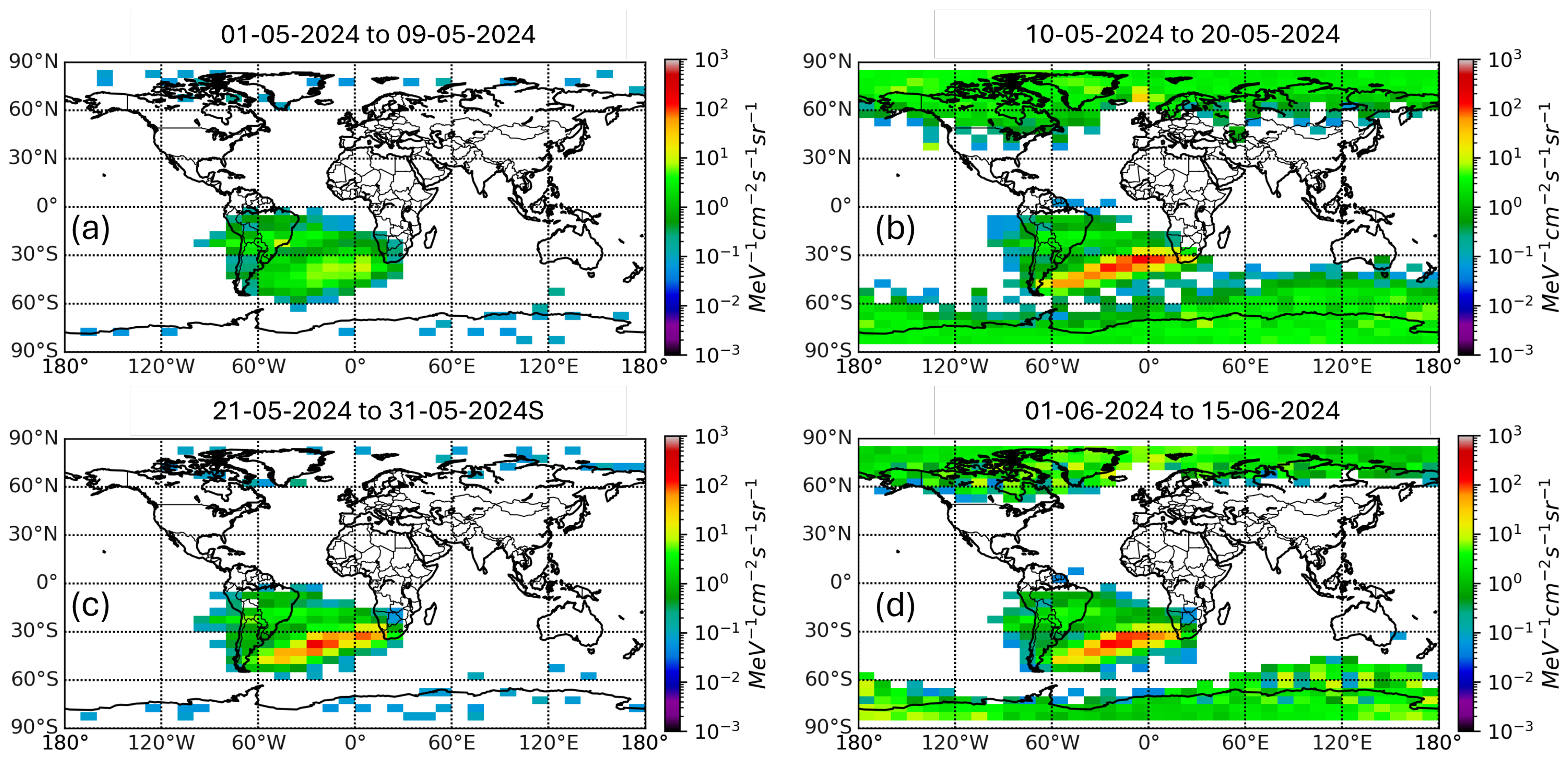
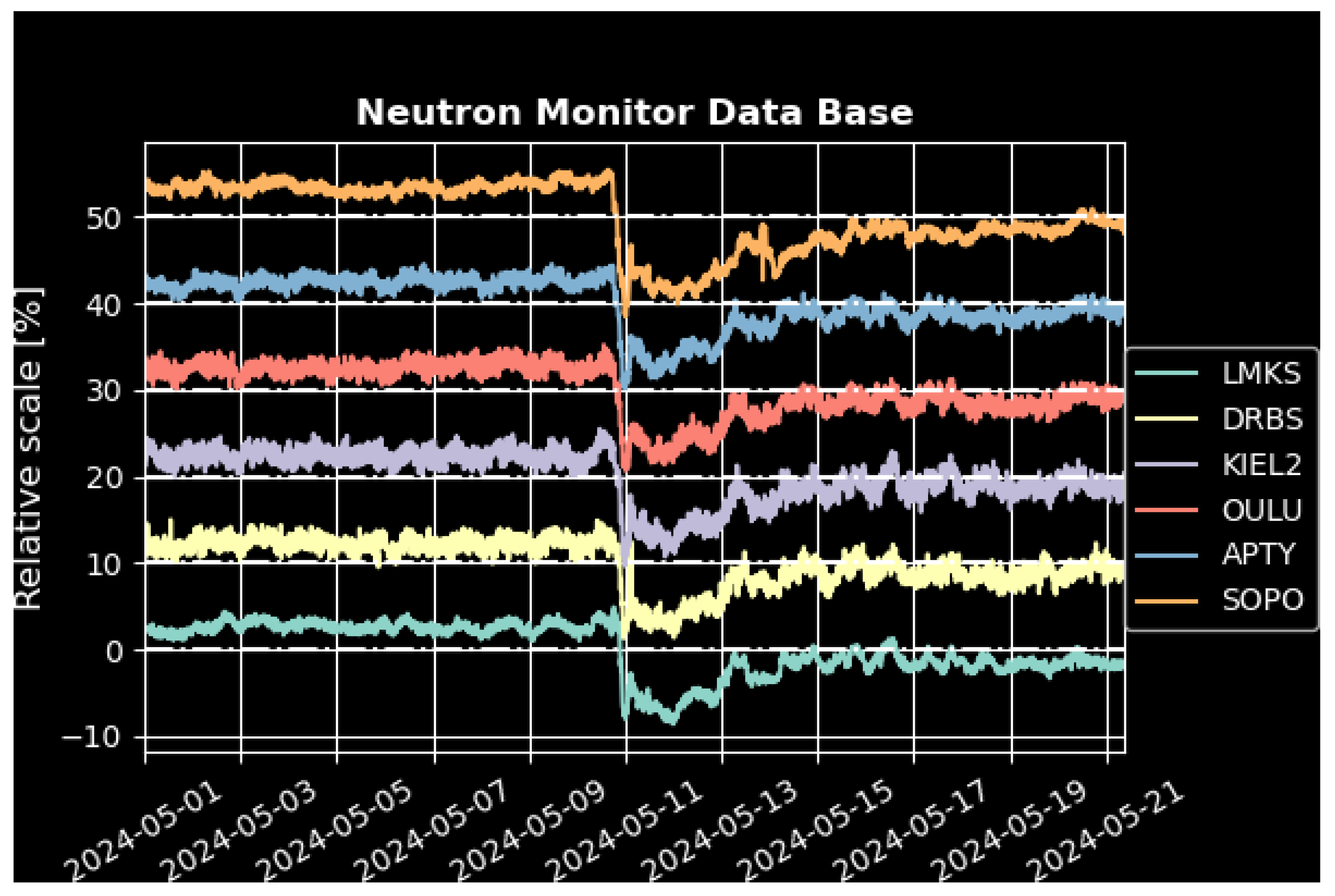
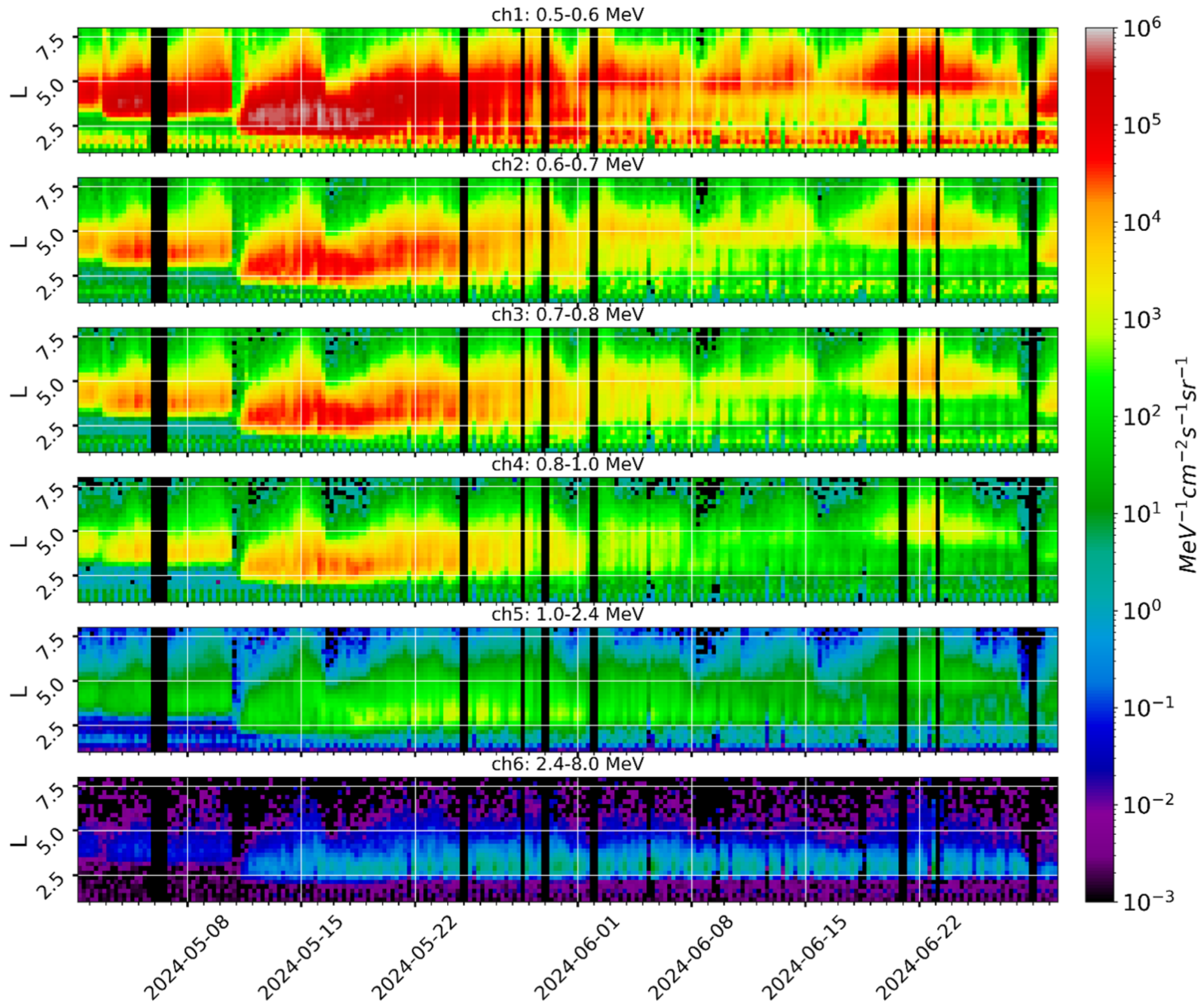
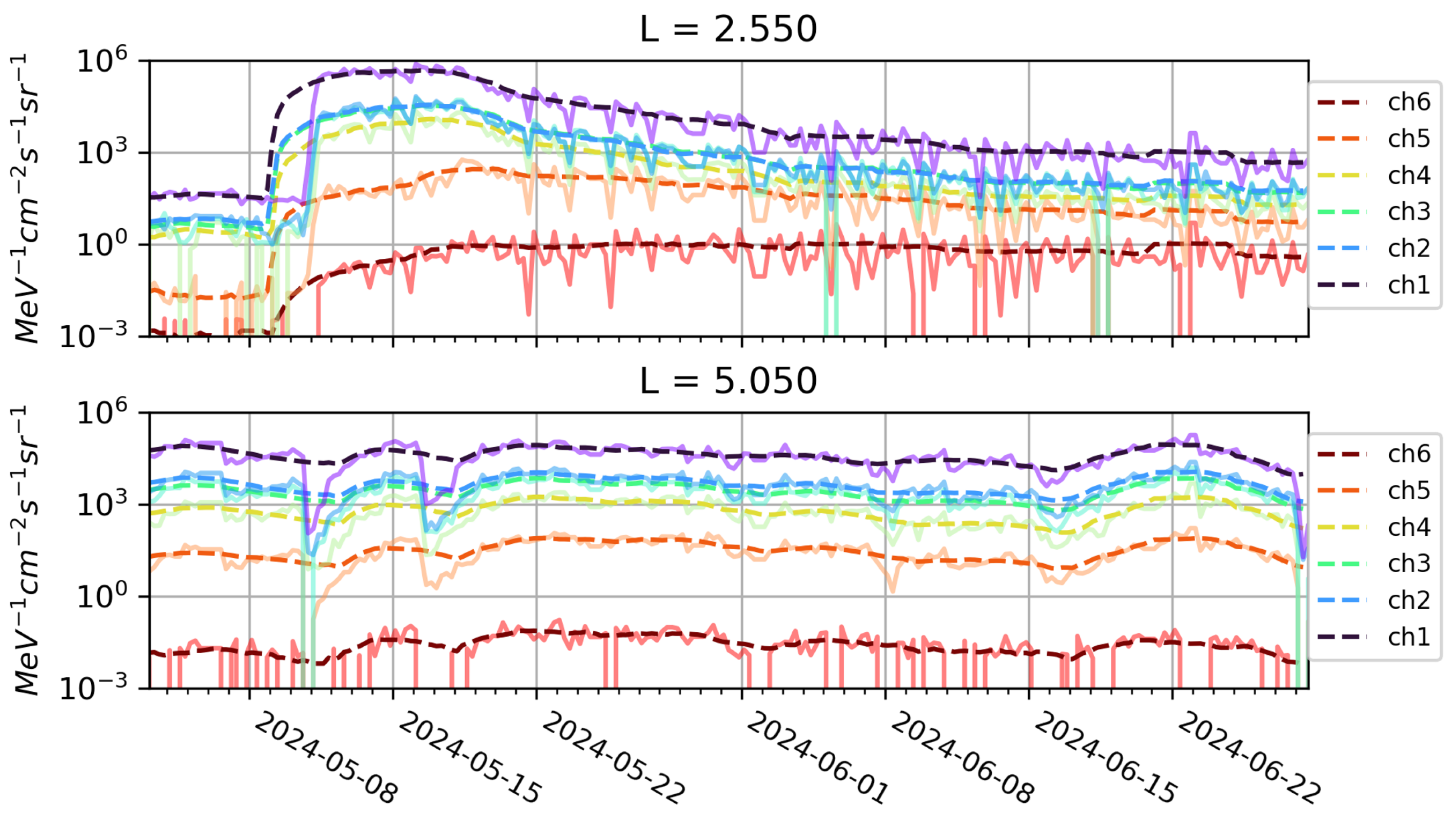
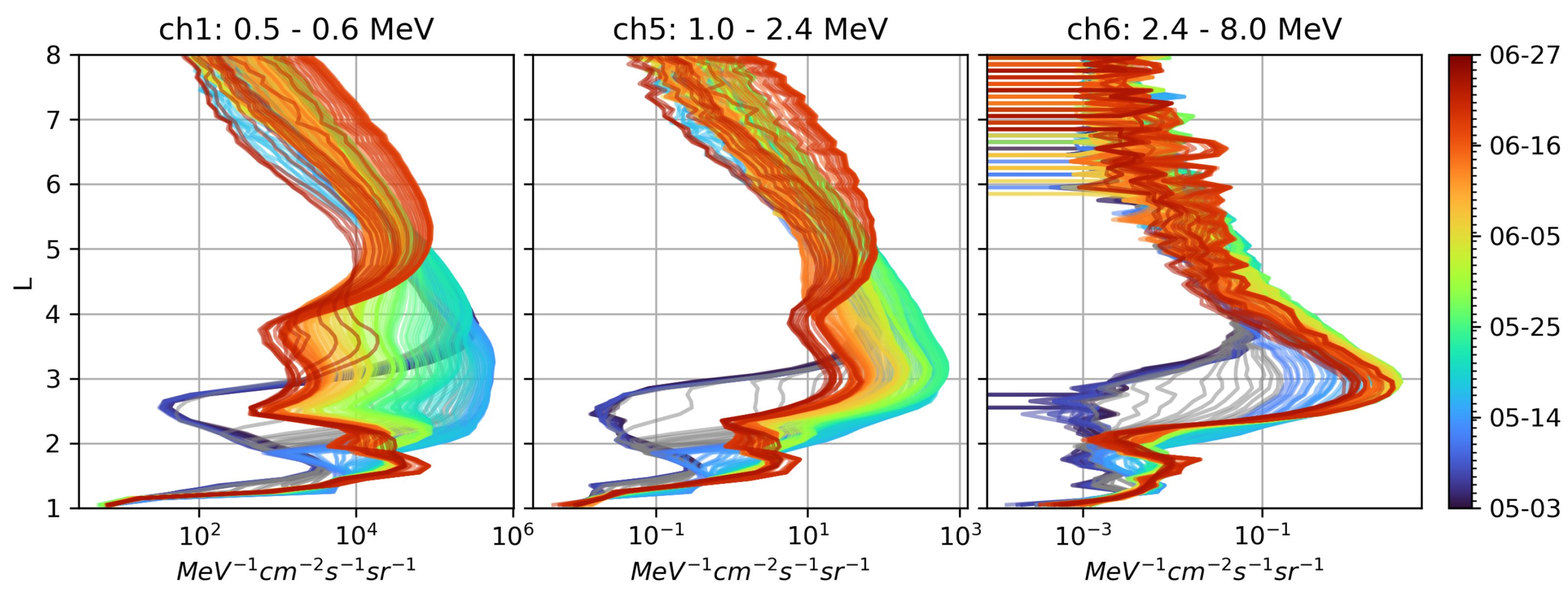
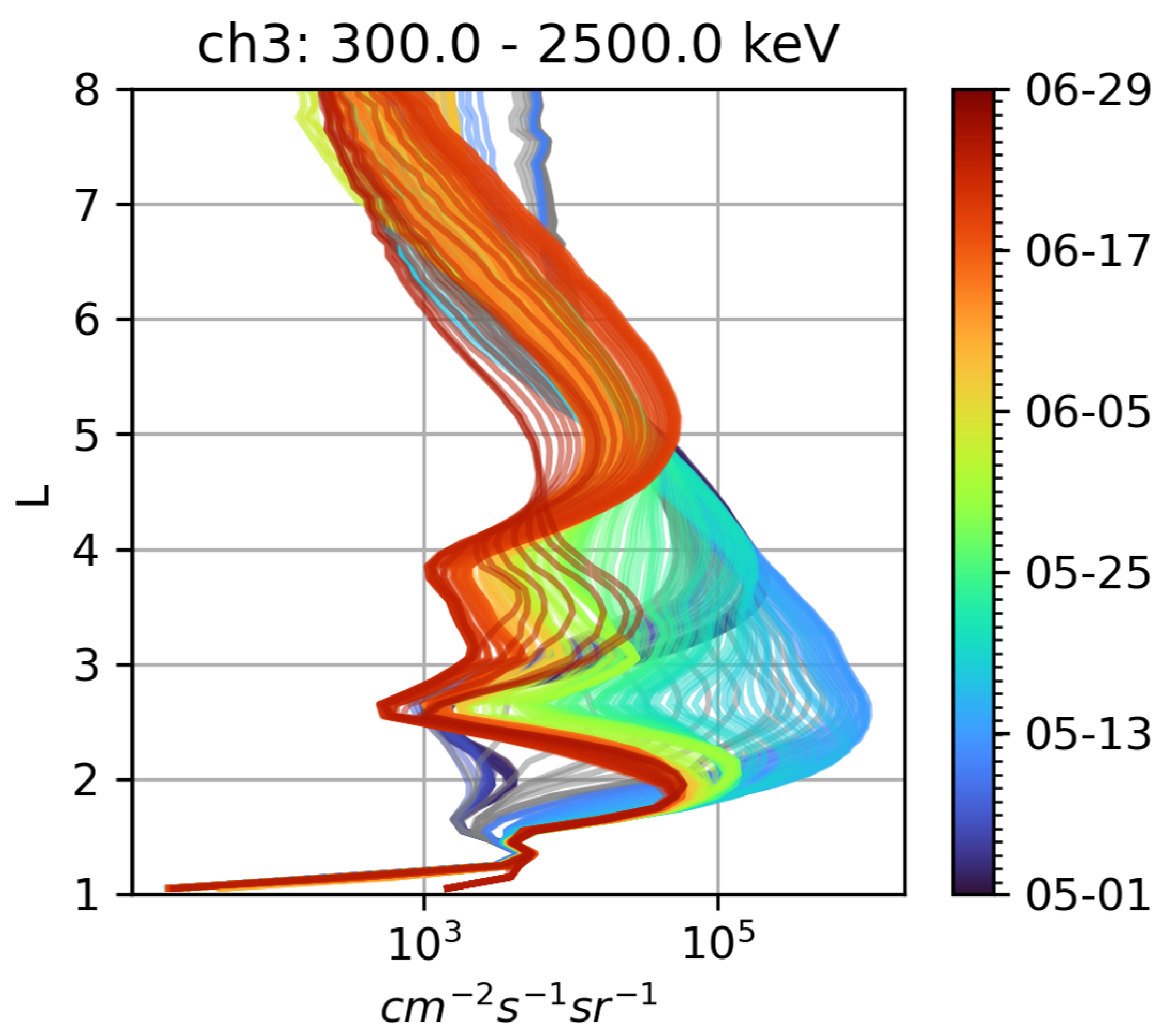
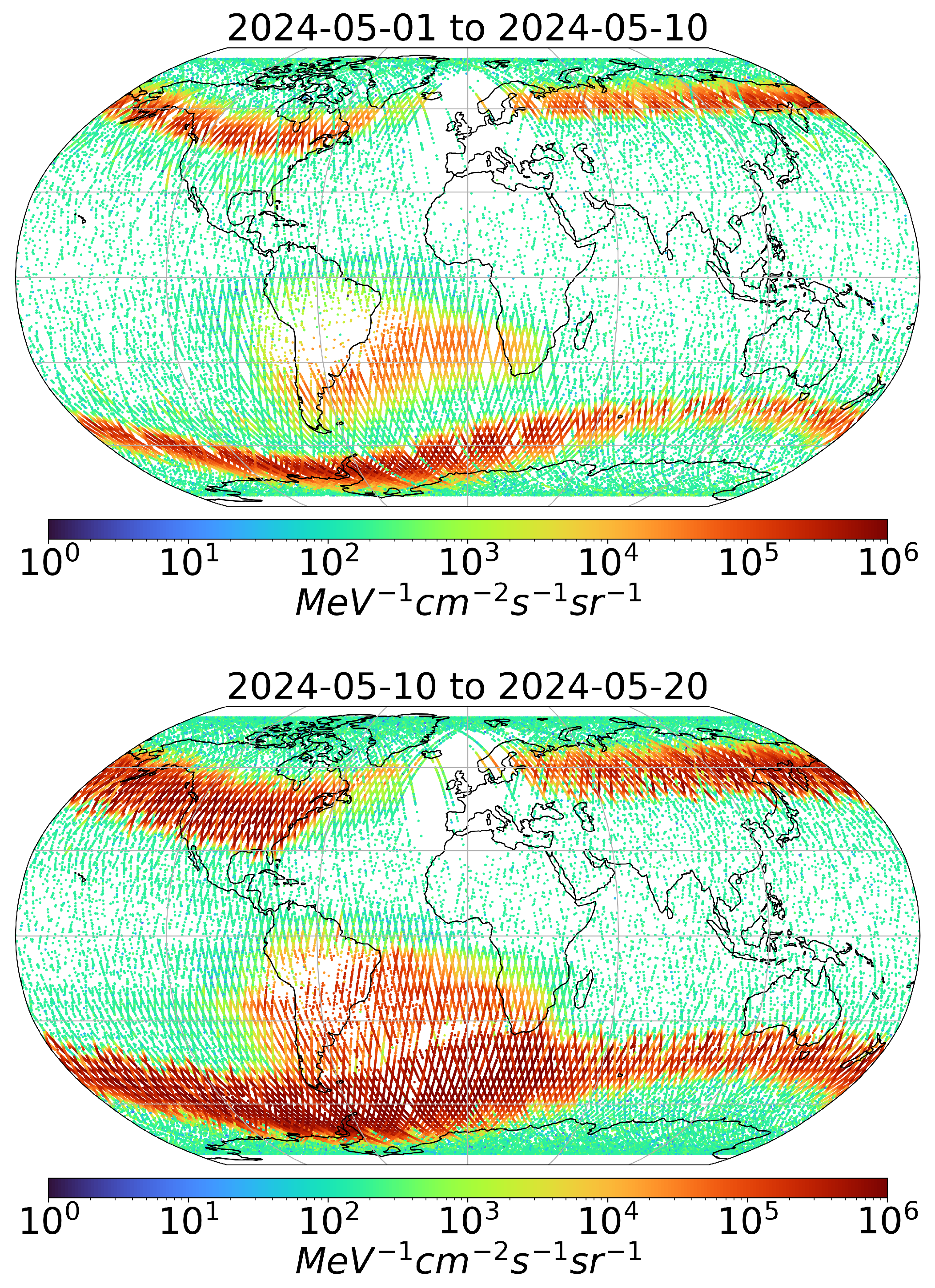
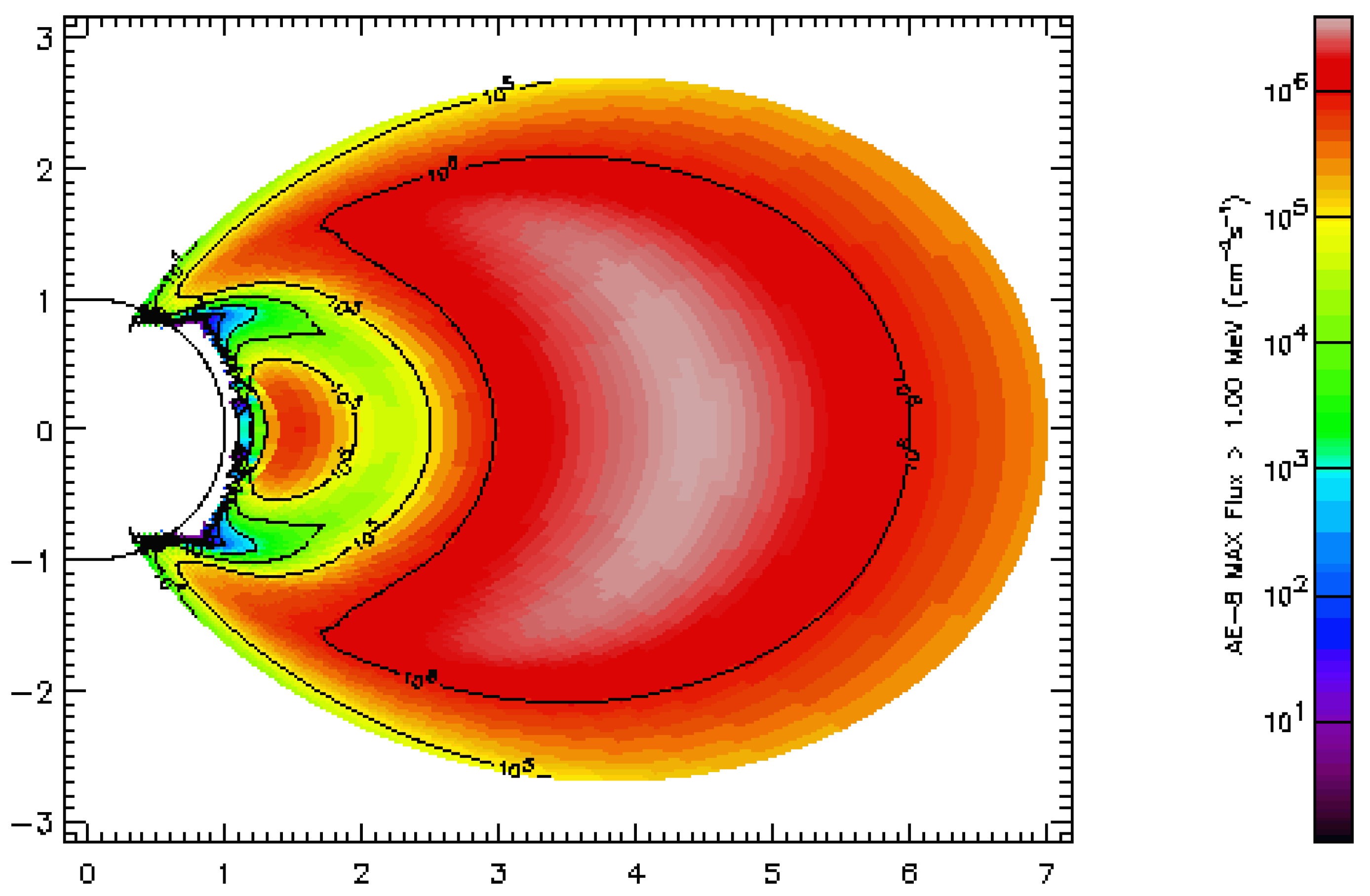
| Full Name | Short Name | Alt (m) | Rc (GV) | Coordinates (Lat, Longitude) in Degree |
|---|---|---|---|---|
| Lomnicky | LMKS | 2634 | 3.84 | 49.2000, 20.2200 |
| Dourbes | DRBS | 225 | 3.18 | 50.0971, 4.59003 |
| Kiel | KIEL | 54 | 2.36 | 54.3399, 10.1199 |
| Oulu | OULU | 15 | 0.81 | 65.0544, 25.4681 |
| Apatity | APTY | 181 | 0.65 | 67.5704, 33.3935 |
| South Pole | SOPO | 2820 | 0.1 | −90.000, 0.00000 |
Disclaimer/Publisher’s Note: The statements, opinions and data contained in all publications are solely those of the individual author(s) and contributor(s) and not of MDPI and/or the editor(s). MDPI and/or the editor(s) disclaim responsibility for any injury to people or property resulting from any ideas, methods, instructions or products referred to in the content. |
© 2024 by the authors. Licensee MDPI, Basel, Switzerland. This article is an open access article distributed under the terms and conditions of the Creative Commons Attribution (CC BY) license (https://creativecommons.org/licenses/by/4.0/).
Share and Cite
Pierrard, V.; Winant, A.; Botek, E.; Péters de Bonhome, M. The Mother’s Day Solar Storm of 11 May 2024 and Its Effect on Earth’s Radiation Belts. Universe 2024, 10, 391. https://doi.org/10.3390/universe10100391
Pierrard V, Winant A, Botek E, Péters de Bonhome M. The Mother’s Day Solar Storm of 11 May 2024 and Its Effect on Earth’s Radiation Belts. Universe. 2024; 10(10):391. https://doi.org/10.3390/universe10100391
Chicago/Turabian StylePierrard, Viviane, Alexandre Winant, Edith Botek, and Maximilien Péters de Bonhome. 2024. "The Mother’s Day Solar Storm of 11 May 2024 and Its Effect on Earth’s Radiation Belts" Universe 10, no. 10: 391. https://doi.org/10.3390/universe10100391
APA StylePierrard, V., Winant, A., Botek, E., & Péters de Bonhome, M. (2024). The Mother’s Day Solar Storm of 11 May 2024 and Its Effect on Earth’s Radiation Belts. Universe, 10(10), 391. https://doi.org/10.3390/universe10100391







